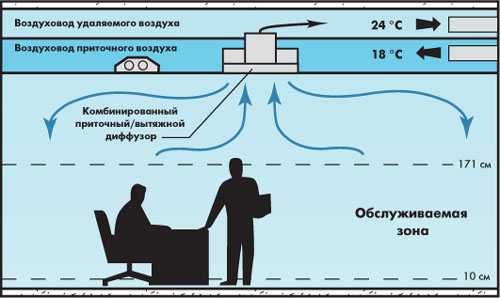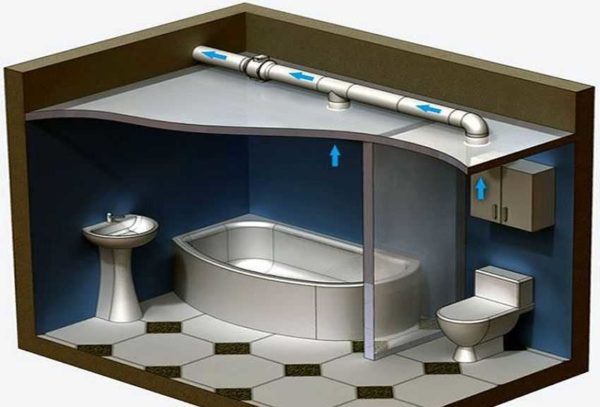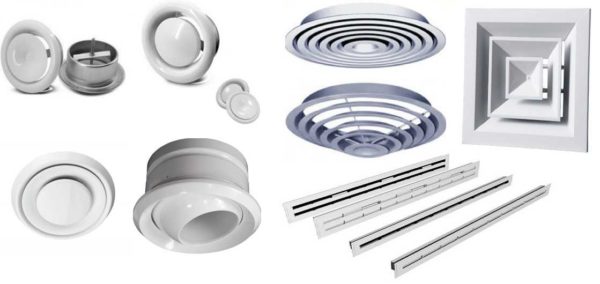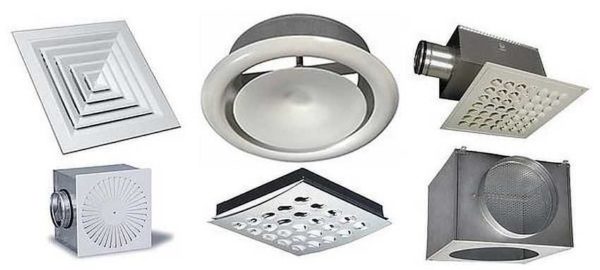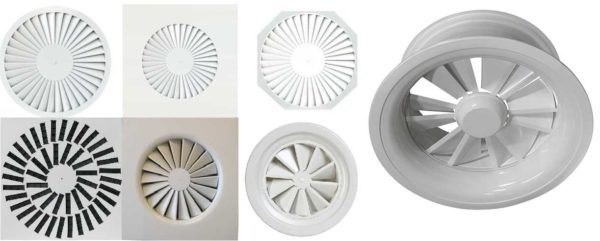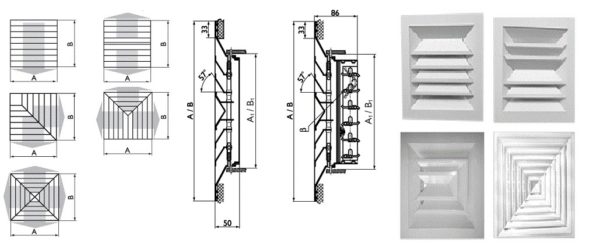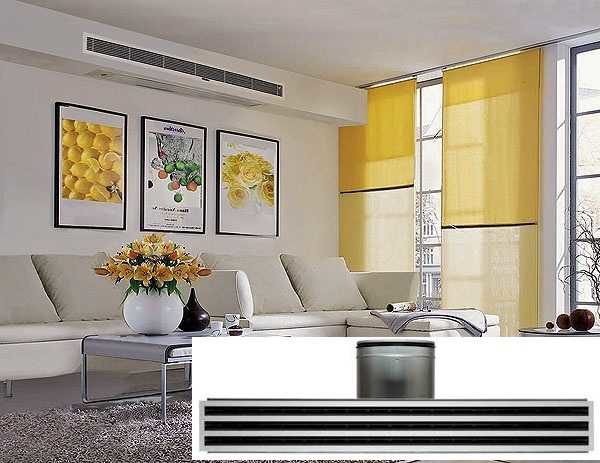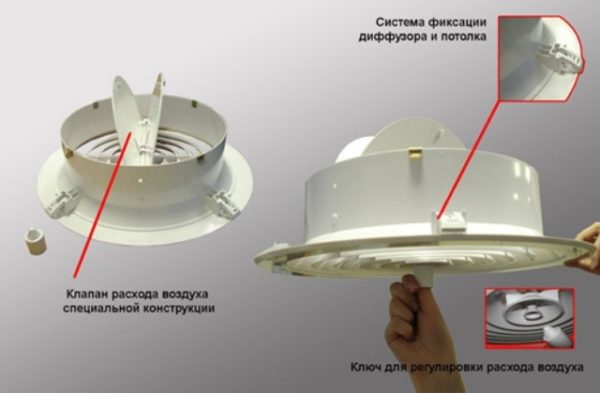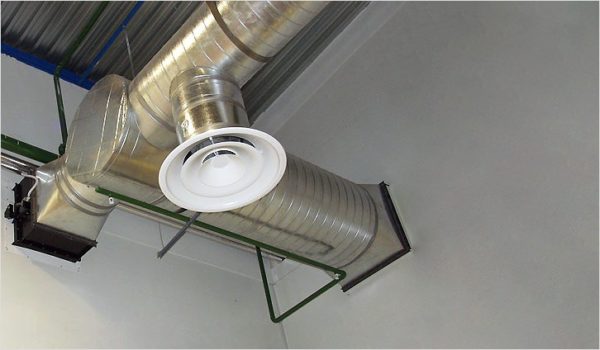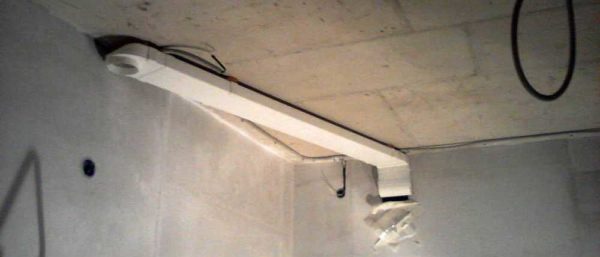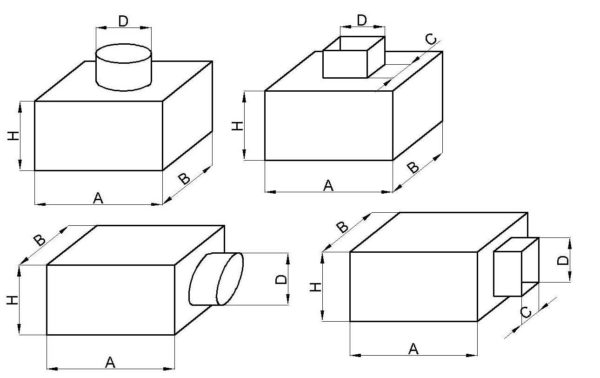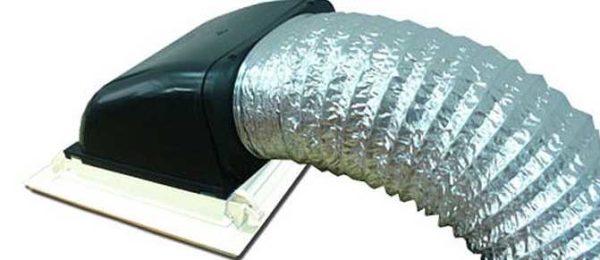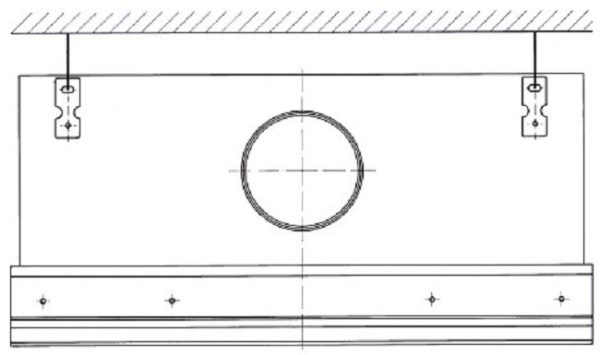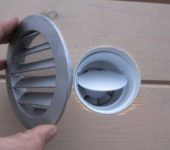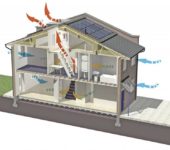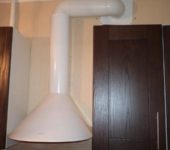Ventilation diffuser - purpose, application, installation
A properly functioning ventilation system is essential for well-being. One of the ventilation components is a ceiling diffuser. Through this device, air is drawn in and supplied.
The content of the article
What is a diffuser
A diffuser is a part of a ventilation system designed to bring in / out air into a room and to mix it effectively. It also performs decorative functions - it closes the entrance / exit to the ventilation duct. Outwardly, it looks like a regular ventilation grill, but it has a slightly more complex structure, it can have additional devices - an impeller and a static pressure chamber.
Difference between diffuser and ventilation grille
What is the difference between a diffuser and a ventilation grill? Yes, actually, nothing. It's just that the ventilation grill is the simplest of the diffusers. Why is the price so different? There are reasons for that.
When developing diffusers, manufacturers calculate the air movement, position the blades and partitions so that the air in the room mixes in the best way. Therefore, the air is mixed, evenly distributed throughout the room.
Manufacturers of cheap ventilation grilles are unlikely to conduct any research, copying external signs and not worrying about efficiency. Air enters a certain point, there are obvious zones with different temperatures. So much for the price difference.
When to install a diffuser
Where and when can ventilation grilles be used and where are diffusers needed? In ordinary apartment buildings of an old building, there are only exhaust ventilation ducts that work due to the pressure difference. Ventilation shafts are located in the walls. In this case, it is possible to install ventilation grids, since the installation of a more complex device has practically no effect on the situation.
But, if you made a false ceiling, behind which you hid the duct connected to this channel, it is advisable to install diffusers. They work more efficiently. Since the presence of a suspended / tensioned structure makes it difficult for air to flow, more efficient devices are needed for the ventilation system to work properly.
If the ventilation system has been specially designed, you will most likely be given precise recommendations as to what, where, what type should be. In such a situation, any replacement can adversely affect the performance of the system.
Diffuser types
In a store or a company that sells ventilation equipment, you will be offered a choice of a large number of diffusers that differ in appearance and materials. It is more or less easy to decide on the materials - choose what you like best or what is better suited to the operating conditions. If the ventilation ducts are made of metal, it is logical (though not necessary) to use metal grilles. They are galvanized, made of stainless steel, or made of ordinary steel, but painted with powder paint.
If the ventilation ducts are made of plastic pipes, they are better connected to plastic diffusers. Here, it seems, everything is clear. The rest of the parameters are a little more complicated, let's figure it out.
Place of use
Diffusers are divided into:
- supply air;
- exhaust;
- universal (supply and exhaust);
- combined.
The names speak for themselves: they are used in different parts of the ventilation system. Supply and exhaust air vents differ in the direction and position of the lamellas and partitions. There is not too much difference, just some work better for air outlet, others for inlet. In principle, you can put the supply air in the hood or vice versa. A disaster will not happen, but the performance of the ventilation system may drop slightly. In private houses and apartments, the difference, due to low productivity, cannot be noticed. Perceptible changes can only be in high performance ventilation.
Universal diffusers allow air to pass through in both directions equally. So you can put them without hesitation. But, as usual, "generalists" work a little worse than specially designed models.
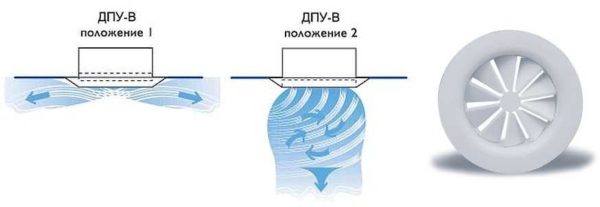
This is how an adjustable supply diffuser works - it changes the direction and shape of the air flow
Explanations are needed only, perhaps, with combined models. They differ in that part of the device works for inflow, part for outflow. Accordingly, they are connected to different parts of the ventilation system. That is, you can install only one universal diffuser on the ceiling, and it will need to be connected to two branches - supply and exhaust. The connection method is described in each specific model, in general it makes no sense to talk about it.
Materials
Diffusers are made from:
- plastics;
- aluminum;
- steel (conventional or stainless).
In private houses and apartments, plastic is most often used. For this situation, this is the best option. At a relatively low price, they have excellent performance characteristics, a long service life, are easy to maintain, and are not subject to corrosion. They fit seamlessly with plastic air ducts, which are increasingly used in private houses.
Metal diffusers are used in industrial premises where only non-combustible materials can be used. They cost significantly more, weigh more, which complicates installation.
There are also diffusers, the outer part of which (grille) is made of wood. Such devices fit perfectly into interior of a wooden house.
Location
At the place of placement, diffusers are:
- ceiling;
- wall-mounted;
- floor-standing.
The most commonly seen ceiling diffuser. They are used in 95% of ventilation systems, both in supply and exhaust systems. Mainly because the air is mixed in the upper part of the room, without causing much discomfort to the person. And also because with the device of false ceilings it is easier to make a ventilation system if it simply did not exist before. Most often, the devices are attached to the main ceiling, and a hole is cut out in the stretch / false ceiling, which is covered by the grill.
Sometimes forced ventilation is done through the basement. Then they put floor diffusers. This phenomenon is very rare.
Wall diffusers are even less common. There are not many situations. For example, in apartments after replacing windows with plastic ones. In this case, an inflow of fresh air is needed and it can only be ensured by making a hole in the wall and installing a diffuser. Or with a lack of fresh air and unwillingness to build / reconstruct the supply system.
Further we will talk about ceiling diffusers, since there are most of them, and all the others still need to be looked for - they are usually delivered to order.
Design features
Ceiling diffusers are available in different designs. There are vortex and slot. These types can be made of any material for any installation method. But, as agreed, we are talking about ceiling models.
Vortex
In them, the lattice partitions are located in such a way as to create turbulences of air masses. This significantly increases the speed of air mixing, increases the performance of the system. It is easy to recognize them by the characteristic radial arrangement of the bridges. A vortex ceiling diffuser is used where rapid air changes are required. It makes sense to install them in bathrooms and toilets - to quickly restore a normal atmosphere, although they are usually used in rooms with a large area and height of ceilings.
The inner part of a vortex ceiling diffuser is usually made in the form of a cylinder, and the grille can be any - round or square, but the holes in it are located strictly along the circumference.
The swirl ceiling diffuser for supply ventilation can have an additional impeller, which is located behind the grille in the housing. The impeller can be mobile or stationary. The movable impeller can be controlled - it can have several rotation speeds.
Another version is with a plenum box. It excludes too active movement of air masses. In the case of ventilation diffusers with a plenum box, even at high flow rates, there will be no drafts in the room.
Slotted
Slotted ceiling diffuser is so called because of the characteristic shape of the holes - in the form of slots. The location of the slots, the shape and size of the partitions are specially designed and calculated. The distribution of air flows depends on their position and direction.
They are used in rooms with low or medium performance of the ventilation system. They are installed in living rooms, technical rooms with normal operating conditions (dressing rooms, storage rooms, built-in wardrobes).
They have one important feature - there are adjustable slot diffusers that can change the direction of the air supply (like the blinds on air conditioners). In terms of types, they can be with or without a plenum box.
They can be of any shape - with a round, rectangular or square outer grille. There are long and narrow models. Such a linear slotted ceiling diffuser is not very conspicuous. In rooms of a certain design (loft, modern), they can serve as a kind of decoration.
Adjustable
To create a comfortable atmosphere in any situation and at any time of the year, there are adjustable diffusers. Sliding plates have been added to their design, the rotation of which changes the throughput.
There is a special name for adjustable diffusers - anemostats. They are adjusted by turning the central part clockwise or counterclockwise. All lamellas in the diffusers are fixed movably, changing their position, they open / close the opening for air passage.
There are also models with built-in presence detectors and air quality analyzers. They are connected to a microclimate control system, which automatically maintains the preset atmospheric conditions. But this is part of a whole expensive system.
Ceiling diffuser: installation
There are two ways to connect diffusers to ventilation ducts: directly or through an adapter (plenum box). More correct is the second option, but it requires a larger gap between the base and decorative ceiling.
If the shape and dimensions of ceiling diffusers and ventilation pipes are the same
To connect the ceiling diffuser directly to the ventilation pipes (bends), a tee / splitter is placed in the ventilation pipe at the installation site. In the free - the third - exit and put the device.
Cutting a hole right in the pipe for its installation is not the right decision. The body protrudes beyond the pipe, making it difficult for air to move, the performance of the system decreases, over time a dust plug still forms, which can generally block the lumen. In general, this should be avoided.
Select taps from the main pipe so that it is convenient to connect them to diffusers. It is not difficult to connect a round diffuser to a round outlet from the duct, and a rectangular one to a rectangular one. It is also important that their sizes match. This simple truth must be remembered when creating a system, choosing tees or making bends with the appropriate parameters.
Diffusers of the same size are installed in ventilation ducts by simply inserting them. Models that are small in size and weight can be fixed to the box with a sealant (silicone neutral). This is how models with a round base are usually attached.
For various types of suspended ceilings (drywall, plastic, Armstrong) developed a special fixation system - Clip in. It is a spacer of the type seen on recessed ceiling luminaires.
More massive square / rectangular models are attached to the walls of the box using self-tapping screws or suspended from the ceiling. The first option is easier, but it is better not to use it, since dust collects on the protruding screw of the self-tapping screw. Is that the design provides for special protrusions for fasteners. Otherwise, over time, a solid plug will form in the place where the self-tapping screw sticks out, preventing the passage of air.
If the bend is made of corrugated material or there is a desire to do everything "right", heavy cases are suspended from the ceiling on studs or hangers.
Using adapters
Adapters or plenums can help you avoid the nuisance of drafts. In this reservoir, an even redistribution of air takes place, which goes in an even flow over the entire surface of the grate. But these devices have a significant drawback - they "steal" the height of the ceiling. Side-connected models are smaller, but still take up enough space.
Most often, the plenum box is a parallelepiped with a diffuser attached to the bottom. There is an outlet for connecting a ventilation duct on top or on the side. It can be of any desired shape: circle, square, rectangle, oval.
There are adapters:
- With built-in rotary valve. If the diffuser model does not provide for adjustment, this can be done using an adapter.
- With removable filter. They also allow you to clean the incoming air.
- With air flow divider. This is a sheet of metal with a small cell. Installed on powerful supply systems, it evenly distributes the air flow over the entire surface of the grill. ...
Static pressure chambers for ventilation diffusers are most often made of galvanized steel. Sheet thickness - 0.5-0.8 mm. There are firms that will make a device according to your parameters. There are also standard adapters on sale - for standard solutions. They can be made of steel (galvanized, stainless) or plastic.
If necessary, the static pressure chamber is sheathed with insulation.This is necessary so that when the warm surface of the adapter and cold air interacts, condensation does not fall on it.
If the diffuser is connected via an adapter, the main task is to secure this device. If it is a suspended ceiling, you can attach the camera to the profiles. In the case of a stretch ceiling, you will have to hang it from the main ceiling. The methods are known: studs or perforated hangers.

